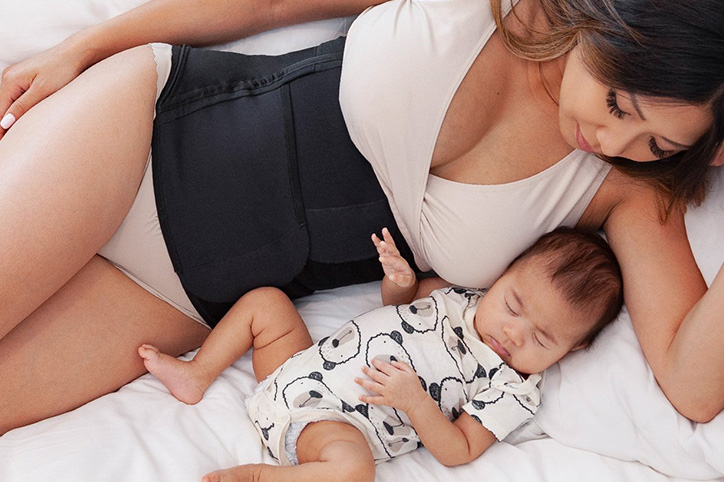Celebrities from Kim Kardashian to Jessica Alba have all raved about waist trainers as they show off their hourglass postpartum figures. In keeping with that there are now a growing number of brands like Belly Bandit and Bumpsuit manufacturing incredibly popular options.
But do they actually work to get postpartum women back to their pre-pregnancy bodies?
First let’s dive deeper into what a waist trainer actually is. “It’s a removable garment that could be considered the modern-day corset,” says physical therapist Blair H Green PT, DPT, OCS, PHC, CSCS. “Companies who make and sell waist trainers claim that they can help re-create an hourglass shape and promote weight loss. These devices have become popular due to many celebrities promoting their use.”
We should also clear up that they are absolutely not recommended or safe to use during pregnancy. “For starters, they constrict the abdomen. Of primary concern during pregnancy is fetal blood flow. With any type of overly-constricting garments, blood flow may be compromised,” says Green. “For pregnant women experiencing low back or pelvic girdle pain, there are other supportive devices and braces designed to grow with the belly and support the woman’s abdomen under the baby bump. Often a physical therapist can make a recommendation on the best back support to use during pregnancy to help women who are experiencing pain.”

Back pain from a growing bump isn’t the only reason some women will opt for waist trainers during pregnancy. Another is fear of developing diastasis recti (ab separation), but that too is not a reason to justify wearing one given the safety concerns. Instead, modify physical activity and seek help from a physical therapist/pelvic floor specialist.
As for postpartum use, while there are countless rave reviews on Instagram, the experts we spoke with said they don’t generally recommend a corset postpartum, unless there is a specific reason. “There could be some benefit as far as facilitating the activation of the abdominal muscles in cases of severe diastasis recti,” says Green. “When there is a severe split and it becomes challenging for a woman to move – get in/out of bed, lift her baby, take care of personal hygiene, etc – sometimes using a corset can help provide support by increasing intra-abdominal pressure and giving a helping hand so to speak. In this situation, I would recommend using a corset during waking hours or when she is exerting effort. The goal is to become strong enough to wear it is no longer needed.” They can also be helpful for their sliming effect when you’re out – think of them like postpartum Spanx, but in this case too the idea is to use them short term.
Otherwise Green cautions using a waist trainer. “The body needs time to heal and our bodies are designed to do that on their own. For anyone experiencing difficulty, there are trained professionals, including pelvic health physical therapists who can provide instruction. Secondly, long-term use of a waist trainer may have a negative effect on the body – restricting blood flow, slowing healing, increasing intra abdominal pressure and putting more stress on the pelvic floor muscles. Think of a balloon: if you squeeze the middle of the balloon, it may pop underneath and, at a minimum, it will bulge out. A waist trainer has a similar effect.”
Green also notes that wearing a corset post c-section may impede tissue healing as it places additional pressure on the pelvic organs.
If you’re going to opt to jump on the waist trainer trend, look for adjustable closures and ones that offer the ability to breathe while they’re in place.




.jpg?w=182&h=122&crop=1)



